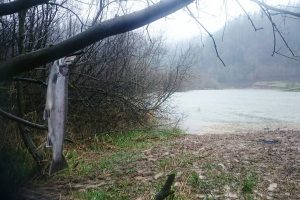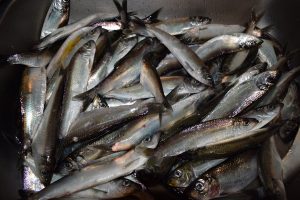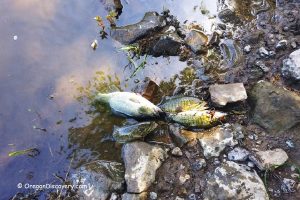Kokanee fishing in Oregon is a popular activity. Kokanees can be found in abundance in many Oregon fishing waters. In fact, Oregon is famous not only for kokanees but also for Sockeye salmon. Although kokanees are common in this region, catching them requires skill and expertise. You must be well- conversant with various details about kokanees in order to have productive fishing sessions.
The name kokanee is derived from the Okanagan word Kootenay. Translated, Kootenay means red. It suits this species of fish owing to their red color, especially among the older fish. The fish are red because the planktons they feed on are full of carotene, which is red in color. These fish closely resemble the Sockeye Salmon.
Some of the waters from where you can catch kokanees in plenty include the Green Peter Reservoir and Odell Lake. If you want to fish productively, take the time to understand the kokanees' life cycle, habitat, and dietary habits. Once you are conversant with the various aspects of their lives, you might even catch as many as 25 fish in a very short period.
Kokanee Life Cycle
Kokanees live up to four years, although some strains live up to a solid seven years. Most of them spawn when they are around four years of age. After spawning, many kokanees simply die. Mating is energy draining for them. The mating period for kokanees is between August and December, after which new schools of fish are brought to existence.
After spawning, the fish change color from the nickel silver they had in their youth to a vivid red and green color. Henceforth, it becomes quite difficult to tell them apart from the Sockeye salmon that have the same exact colors.
Food
Kokanees primarily eat zooplanktons. One of the most common zooplanktons is known as Daphnia, although it is more commonly known as the water flea. Because zooplanktons are sensitive to light, kokanees tend to avoid brightly illuminated places as well.
Therefore, when you are fishing, you would be well advised to steer clear of very well-lit places as there are low chances of finding your desired catch here. Kokanees filter out the zooplankton from the water using their gill rakes. Gill rakes resemble fine-toothed combs, and quite predictably, they are found just outside the gills.
Other than the zooplanktons, kokanees also feed on small insects, plants, shrimp and even larvae.
Habitat
Temperatures dictate where these fish can stay. They are exceedingly sensitive to extremes in temperature. The ideal water temperature for kokanees is 50°F. If the fish stay for too long in waters whose temperatures exceed 55°F, they are highly likely to die.
During the warm months, the fish are most likely to be found in the thermocline section of a lake. The thermocline is the area where warm water from the surface meets the cold water from the bottom of the lake. In addition to the water being at just the right temperature, it is also very rich in oxygen, which is invaluable to the existence of fish.
Planktons may be floating higher in the water where temperatures are beyond what the fish can stand. In this case, the kokanees will go up periodically then come down to find relief in the cooler waters. Given how important it is for the fish to stay at the right temperatures, it is imperative that you also know the temperatures when Kokanee fishing in Oregon.
For you to achieve this, you will need to rely heavily on some fishing equipment such as thermometers. Buy the best thermometer you can afford. The higher the quality, the better the accuracy, and quite likely, the more rewarding your fishing session will be.
Kokanee Fishing Tips
Much like with ordinary fishing, the first thing to do when kokanee fish is to find the fish. The easiest way to find the fish is using fish finders. Once you locate the school of fish, you will have to lure them.
Next, you need to cast your reel and wait for the fish to fall for your trap. You could also opt to troll rather than use the lines and reels. If you do choose to troll, you would be well advised to troll with or against the wind, but never sideways. If you troll sideways, you are highly likely to get your lines all tangled up. Also, aim at trolling at low speeds for the best results.
Best Fishing Equipment to Use
Kokanee has very soft mouths, therefore, pick the softest rod you can find. Also, choose light reels as they prevent the fish from escaping. Light reels have a high center of gravity, and their pivot point is very smooth. When shopping for hooks, choose drop shot hooks because they will be deeply buried in the mouth of the fish, preventing possible escape.
To Catch them Easily, Pay Attention to their Senses
Eyesight: Eyesight may not be the strongest physical sense for kokanees, but they sure know how to tell that a foreign object has found its way into their hallowed sanctuary. Kokanees are very territorial, and brightly colored objects will certainly infuriate them. When they come to attack the intruder, you can take the liberty to catch as many of them as you wish.
Hearing: Just like with eyesight, hearing is not particularly strong for kokanees. However, if they hear anything unusual, they will show up to defend their territory. And when the noise you make catches the attention of a whole school of these fish, then you will certainly go home a happy person.
Smell: Their sense of smell is incredibly sharp. This is a double edge sword for anglers. Because they are super sensitive to smell, these fish will smell you out from miles away and make their escape in good time. You can, however, turn this strength into a weakness. You can purchase scents that resemble those of their fellow fish or the food they eat.
Hopefully, they will fall for your tricks and come rushing to where you are.
Conclusion
Fishing for kokanees can be both fun and productive. It is especially rewarding if you have taken the time to study the behavior of the fish. Have a fun time kokanee fishing in Oregon. It’s an experience you would want to relive over and over again.
You May Also Like








